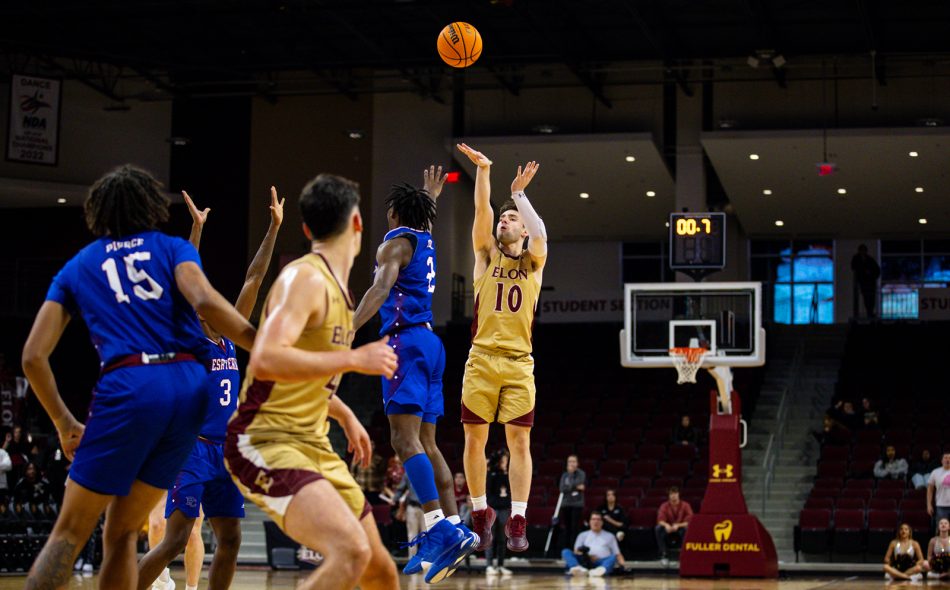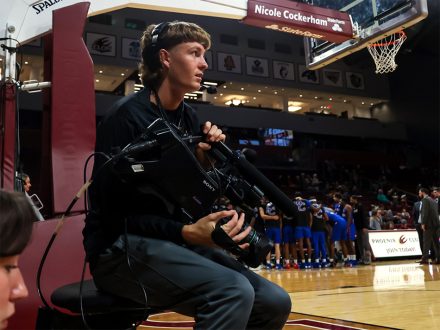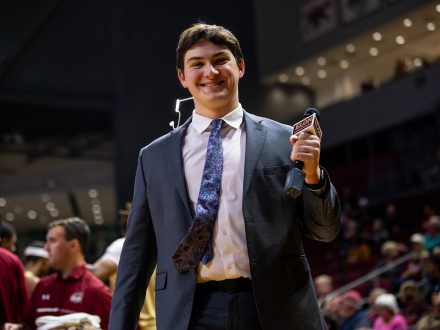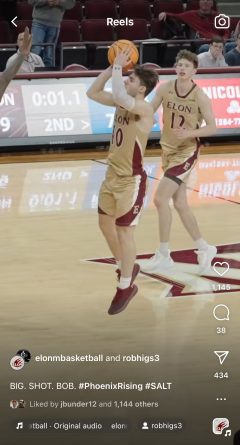Rob Higgins and the Elon men’s basketball team might have won the game, but that’s just part of the story. Here’s a deep dive into Elon’s last-second win over Presbyterian College and how ESV chronicled the moment that landed on ESPN’s “SportsCenter.”

In the seconds before Rob Higgins hit the most memorable shot of the Elon men’s basketball team’s season – a moment ESPN’s “SportsCenter” immortalized as its top play of the day – Claire Geary was drawing up her own game plan.
The coordinating producer for Elon Sports Vision wasn’t contemplating basketball strategy, but rather her live broadcast. And she had a simple directive for camera operator Thomas Ostrom ’24: shoot wide. Ostrom had to be certain his camera angle included the shot clock on a last-second heave.

“One of the biggest components to a buzzer-beater moment is making sure the viewer can see the shot clock read ‘zero,’” Geary said. “As the producer of the show, I was thinking of a lot of things at that moment – like the possibility of overtime. But in the end, I was just focused on making sure we told the full story.”
A few weeks removed from Elon’s 82-79 win over Presbyterian College, many sports fans – and millions of cable subscribers – know how the Nov. 27 contest played out. With 3.7 seconds left, Higgins raced across the court and launched an on-target three-pointer from the top of the key. With his emotions carrying him around the court, Higgins flashed three fingers as his jubilant teammates sprinted behind him, and eventually engulfed him.
It had all the theatrics one would expect of an ESPN highlight.
What wasn’t visible were the moments before and after the shot in the Schar Center control room, where Geary and her team of 16 students brought the broadcast to life, orchestrating beauty amid the chaos.
In the director’s chair for the Elon broadcast was Nate Romano ’25, a cinema & television arts major, whom Geary commends for his steady hand and unshakable demeanor.
As the game hung in the balance, Romano concentrated on what the viewer needed. He seconded Geary’s call for wide-angle shots. And, if the situation played out, the camera operators were instructed to follow the player who made the winning shot. Just as important, Geary and Romano wanted to make sure a camera was also on any expressive Presbyterian players.
“Whenever something like that happens, there is always two sides to the story,” Romano said. “One team will be celebrating and euphoric, and the other team is just going to be broken. You want to be sure to broadcast both of those emotions for those watching.”
With Higgins providing the heroics, Romano’s plan came together, too.
Caden Strickland ’26, who was operating the camera under the opponent’s basket, followed Higgins as he made his way to celebrate in the student section. The broadcast then flipped to camera operator Ella Smith ’26, who was recording a tight angle on Presbyterian’s Kobe Stewart, whose hands draped across his forehead and nearly covered his crestfallen face.
“In hindsight, there was not one bad angle, which was fantastic,” Geary said. “We were able to show the emotion and pain of both stories.”
Pulling in one direction
Just how early did Geary start prepping for the late November match-up between Elon and Presbyterian? Well, she scheduled her staff more than three weeks beforehand, she recalled.
With Elon Sports Vision’s roster of nearly 60 students, Geary works well in advance to build a broadcast’s student staff. The students are welcome to apply for a variety of jobs, and she places them according to their availability and strengths, but also where they can improve.
For a bare-bones broadcast, Elon Sports Vision will have 10 students – four on cameras, four in the control room and two broadcasters (or talent). For the Presbyterian contest, 16 students were on the FloSports live broadcast. This allowed for ample staffing for inexperienced students to shadow upperclassmen.
“I consider myself the captain of the ship,” Geary said. “I have my co-captains, first mate, second mate, third mate. Guys in charge of the ropes. It takes a lot of people to make the broadcast sail.”
Who was the Nov. 27 broadcast’s unsung sailor – err, hero? Romano conferred that title to Philip Doherty ’26, a cinema & television arts major, who oversaw the replay system.
“Phillip kept giving me great looks, but he is always on his game,” Romano said. “There were a lot of people who put in great work, but I don’t think the broadcast would have been as good without him working replay.”
From a producer’s perspective, Geary said she couldn’t have asked for more.
“We got all three camera angles in. We slowed it down. We were able to re-showcase what needed to be shown. I wouldn’t redo the replay sequence,” she said. “Honestly, that is my proudest moment as a producer at Elon.”
Ask the obvious question
While Higgins ended the game in specular fashion, the broadcast wasn’t over.
In the aftermath of the shot, the control room erupted into cheers for a few seconds. Admittedly, the Elon student staff was a bit partisan. The cheering on the multiview recording is evidence of that.
But Romano, Geary and others quickly fell into their post-game responsibilities.

Geary pivoted to get Chase Strawser ’25, the broadcast’s sideline reporter, prepped and ready to interview head coach Billy Taylor. She remembers offering two instructions in the game’s closing minutes. First, Strawser needed to hold the microphone in his right hand, so he didn’t awkwardly reach across to mic Taylor.
And two, by gosh, he needed to ask about the game-winner.
“Because students often prepare questions ahead of time, they can get caught up in the moment and forget,” Geary said.
Strawser checked all necessary interview boxes with Taylor, overcoming nerves and the adrenaline of the moment. “It’s not every week you get to interview a coach directly after a play like that,” the journalism and sport management double-major said.
As the broadcast segued from immediate replays to the Strawser-Taylor interview, Doherty and Annie Thyfault ’26 frantically worked to build a minute-long package of the best highlights and plays to conclude the broadcast. Geary was confident the duo would shine. “Annie and Philip are the best at that,” Geary said matter-of-factly.
As the package rolled out, commentators Taylor Durham ’96 and Will Roberson completed the broadcast’s final housekeeping, offering statistics and final words. And that was a wrap.
Geary can still remember the control room’s collective sigh of relief. The students then transitioned to breaking down cameras and equipment before their customary post-mortem, with Geary providing insights and advice. Fittingly, the 10-minute gathering was held on the court.
Just as in the moment, Romano remains elated with his team’s efforts. But in hindsight would he change anything? Well, maybe one shot.
“One camera has a little bit of a zoom out in the broadcast when I watched it back,” he said. “Generally, that is not what you want. But looking at it again, it actually looks kind of cool, too.”
A ‘SportsCenter’ moment
Interestingly, there was more than one victory following Higgins’ shot.
The day after the game, the men’s basketball team garnered national attention as the No. 1 play on ESPN’s “SportsCenter” Top 10, a daily ranking of the most spectacular plays in sports. In terms of national exposure, it was also a huge win for Elon, said Jennifer Strawley, the university’s new athletic director.
Since arriving from the University of Miami this summer, Strawley said she has begun to understand the Elon experience, and the opportunities students have to chart their respective paths.

“As I reflected and thought about what makes this broadcast special, it wasn’t just about a student hitting a shot, but that the moment was also captured by students through Elon Sports Vision,” she said. “With that one big play, we created exposure and opportunities for so many. It really exemplifies what our partnership with the School of Communications is all about.”
Beyond a professional-level presentation, what Elon Sports Vision truly provides is growth opportunities, according to several students.
Romano said he arrived on campus with aspirations to be in front of the camera, not behind it. But his experiences with ESV changed his course.
“Originally, I wanted to be the guy calling the games,” he said. “But I started working with cameras, handling roles in the control room, and I ended up enjoying that so much more than I would calling the game.”
As he prepares to study in the Elon in LA program this summer, Romano hopes to intern in sports broadcasting and production.
Doherty, who hails from Athens, Georgia, said he doubts he’d get so many chances to build his skill set on another college campus. “ESV has been crucial to my experience at Elon, teaching me tons of things that I wouldn’t get to learn at a much bigger school,” he said.
For Geary, the opportunities for students to try, fail, succeed and repeat is the real value of Elon Sports Vision. Each game is a chance to learn – regardless of the scoreboard.
“That is why you have students in these positions, so they can build upon each play, each game, each broadcast,” she said. “Elon Sports Vision shows how important student involvement can be.”


